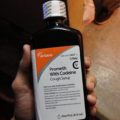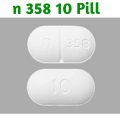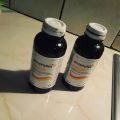Stilpane Syrup is a medication that contains three active ingredients: paracetamol, codeine, and caffeine. This combination is commonly used to treat mild to moderate pain, particularly headaches, migraines, toothaches, menstrual cramps, and other similar conditions.
In this article, we will discuss Stilpane Syrup in detail, including its ingredients, uses, dosages, side effects, precautions, and interactions.
Ingredients
Stilpane Syrup contains the following three active ingredients:
- Paracetamol: Paracetamol, also known as acetaminophen, is a commonly used medication to reduce pain and fever. It works by blocking the production of certain chemicals in the body that cause pain and inflammation. Paracetamol is widely available over-the-counter and is considered safe when taken in the recommended doses.
- Codeine: Codeine is a narcotic pain reliever that works by blocking pain signals from the brain. It is commonly used to treat mild to moderate pain, coughing, and diarrhea. Codeine can be habit-forming if taken in high doses or for extended periods.
- Caffeine: Caffeine is a stimulant that can help to enhance the effects of pain medication. It works by narrowing the blood vessels in the brain, which can help to reduce headache symptoms. Caffeine is commonly found in tea, coffee, and many soft drinks.
Uses
Stilpane Syrup is primarily used to treat mild to moderate pain, particularly headaches, migraines, toothaches, menstrual cramps, and other similar conditions. It can also be used to treat fever, coughing, and diarrhea, although these uses are less common.
Dosages
Stilpane Syrup should only be taken as directed by a healthcare professional. The recommended dosage will depend on the individual’s age, weight, and the severity of their condition. In general, the maximum daily dose of paracetamol for adults is 4,000 mg, while the maximum daily dose of codeine is 240 mg.
The following dosages are typical for adults:
- For mild to moderate pain: 10-20 ml every 4-6 hours, as needed
- For fever: 10-20 ml every 4-6 hours, as needed
- For coughing: 10-20 ml every 4-6 hours, as needed
- For diarrhea: 10-20 ml every 4-6 hours, as needed
It is important to note that Stilpane Syrup should not be taken for longer than recommended, as it can be habit-forming and lead to addiction. Additionally, it should not be taken with other medications that contain paracetamol or codeine, as this can increase the risk of overdose.
Side Effects
Like all medications, Stilpane Syrup can cause side effects. The most common side effects include:
- Nausea
- Dizziness
- Drowsiness
- Constipation
- Dry mouth
- Blurred vision
- Sweating
- Rash
- Itching
Less commonly, Stilpane Syrup can cause more serious side effects, including:
- Difficulty breathing
- Seizures
- Chest pain
- Irregular heartbeat
- Hallucinations
- Confusion
- Depression
- Liver damage
If any of these serious side effects occur, it is important to seek medical attention immediately.
Precautions
There are several precautions that should be taken when using Stilpane Syrup. These include:
- Not taking Stilpane Syrup if you are allergic to any of its ingredients
- Not taking Stilpane Syrup if you have severe liver or kidney disease
- Not taking Stilpane Syrup if you are pregnant or breastfeeding without consulting a healthcare professional
- Not taking Stilpane Syrup with other medications that contain paracetamol or codeine
- Not exceeding the recommended dose or taking Stilpane Syrup for longer than recommended
- Using caution when operating heavy machinery or driving, as Stilpane Syrup can cause dizziness and drowsiness
- Avoiding alcohol while taking Stilpane Syrup, as it can increase the risk of side effects
- Informing your healthcare provider of any other medications or supplements you are taking before using Stilpane Syrup
Interactions
Stilpane Syrup can interact with other medications, including:
- Alcohol: Drinking alcohol while taking Stilpane Syrup can increase the risk of side effects, including liver damage and drowsiness.
- Blood thinners: Stilpane Syrup can interact with blood thinners, such as warfarin, increasing the risk of bleeding.
- Antidepressants: Stilpane Syrup can interact with certain antidepressants, such as monoamine oxidase inhibitors (MAOIs), increasing the risk of serotonin syndrome.
- Other pain medications: Taking Stilpane Syrup with other pain medications can increase the risk of side effects, including drowsiness, dizziness, and respiratory depression.
It is important to inform your healthcare provider of all medications and supplements you are taking before using Stilpane Syrup.
Stilpane Syrup Addiction
Stilpane Syrup contains codeine, which is an opioid medication that can be habit-forming and lead to addiction if not used properly. While Stilpane Syrup is intended for short-term use to relieve pain or fever, some people may continue to use the medication beyond its recommended duration or in higher doses than prescribed, which can increase the risk of developing an addiction.
Symptoms of Stilpane Syrup addiction:
- Cravings for the medication
- Difficulty controlling the use of the medication
- Continued use of the medication despite negative consequences
- Taking more of the medication than prescribed or using it more frequently than directed
- Withdrawal symptoms when attempting to stop using the medication, such as nausea, vomiting, sweating, diarrhea, and muscle aches
- Neglecting responsibilities or activities in favor of using the medication
- Using the medication despite knowing it is causing harm to oneself or others
Treatment for Stilpane Syrup Addiction
If someone is addicted to Stilpane Syrup, it is important for them to seek professional help to overcome their addiction. Treatment for Stilpane Syrup addiction may include:
- Medical detoxification: This involves gradually reducing the dose of Stilpane Syrup to avoid withdrawal symptoms, under the supervision of a healthcare professional.
- Behavioral therapy: This type of therapy can help individuals identify and change behaviors that contribute to addiction, as well as teach them coping mechanisms and life skills to maintain sobriety.
- Support groups: Joining a support group, such as Narcotics Anonymous, can provide individuals with a sense of community and support from others who are also recovering from addiction.
- Medications: Certain medications, such as buprenorphine or methadone, may be used to manage withdrawal symptoms and reduce cravings.
Prevention of Stilpane Syrup Addiction
To prevent Stilpane Syrup addiction, it is important to use the medication only as directed by a healthcare professional and to avoid taking more of the medication than prescribed or using it for longer than recommended. Individuals who have a history of substance abuse or addiction may be at a higher risk of developing an addiction to Stilpane Syrup and should discuss alternative pain management options with their healthcare provider. It is also important to store Stilpane Syrup in a secure location and dispose of any unused medication properly to avoid the risk of misuse or abuse by others.






